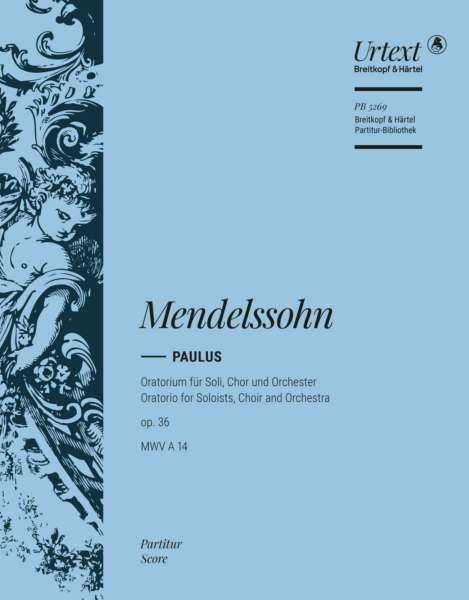Felix Mendelssohn Bartholdy (1809–1847) Paulus op. 36 MWV A 14
Oratorium nach Worten der Heiligen Schrift – Urtext herausgegeben von Michael Märker [Soli,GCh,Orch] Dauer: 130'
Soli: SATBB – Chor: SSAATB – 2.2.2.2.Kfg.Serp – 4.2.3.0 – Pk – Org – Str
Märkers Urtext-Ausgabe liegt der Partitur-Erstdruck von 1835 zugrunde.
Hier können Sie in EB 8706 blättern.
Nachdem Sie die gewünschten Ausgaben in den Warenkorb gelegt haben, können Sie dort die benötigte Stückzahl bei Bedarf noch anpassen.
Das Paulus-Oratorium erweist sich – wie nicht selten bei Mendelssohn – als regelrechtes „work in progress“. Nach der Uraufführung 1836 in Düsseldorf seufzte der Komponist: „Da ich noch so manches geändert habe, namentlich in den Recitativen, und einige Stücke ganz weggelassen, so weiß ich wirklich kaum, wie diese Abänderungen in den schon gestochenen Quartettstimmen zu machen sein werden.“ Glücklicherweise war die Partitur zu diesem Zeitpunkt noch nicht gedruckt. Sie kam indes bald danach (1837) heraus und lag dann auch der alten Gesamtausgabe zugrunde, wo sie jedoch mit anderen Quellen vermischt wurde.
Die vorliegende Urtext-Ausgabe von Michael Märker benutzt erstmals den Erstdruck der Partitur als Hauptquelle. Deren Inkonsequenzen wurden vom Herausgeber in Abstimmung mit anderen zeitgenössischen Quellen berichtigt.
„Mit der Rückführung der überlieferten Fassung von Julius Rietz (1878), die allen späteren Nachdrucken zugrunde liegt, auf die vom Komponisten verantwortete Partitur des Erstdrucks 1835 tritt eine von manchen angleichenden Abschleifungen befreite, im Detail zuweilen kantigere und damit zugleich charakteristischere Gestalt des Paulus zu tage.“ (Michael Märker zur Neuausgabe 1997)
| Teil 1 (I): Ouvertüre - Herr, der du bist der Gott - Allein Gott in der Höh sei Ehr - Die Menge der Gläubigen war ein Herz - Dieser Mensch hört nicht auf zu reden Lästerworte - Und sie sahen auf ihn alle - Jerusalem! Die du tötest die Propheten - |
| Teil 1 (II): Sie aber stürmten auf ihn ein - Und sie steinigten ihn - Und die Zeugen legten ab ihre Kleider - Siehe! Wir preisen selig, die erduldet haben - Saulus aber zerstörte die Gemeinde - Und zog mit einer Schar gen Damaskus - |
| Teil 1 (III): Und als er auf dem Wege war - Mache dich auf! Werde Licht! - Wachet auf!‘ ruft uns die Stimme - Die Männer aber, die seine Gefährten waren - Gott, sei mir gnädig nach deiner Güte - Es war aber ein Jünger zu Damaskus - |
| Teil 1 (IV): Ich danke dir, Herr, mein Gott - Und Ananias ging hin - O welch eine Tiefe des Reichtums der Weisheit und Erkenntnis Gottes! |
| Teil 2 (I): Der Erdkreis ist nun des Herrn - Und Paulus kam zu der Gemeinde - So sind wir nun Botschafter an Christi statt - Wie lieblich sind die Boten, die den Frieden verkündigen - Wie sie ausgesandt vom heiligen Geist - |
| Teil 2 (II): Da aber die Juden das Volk sahen - Ist das nicht, der zu Jerusalem verstörte alle? - Paulus aber und Barnabas sprachen - Denn also hat der Herr geboten - Und es war ein Mann zu Lystra - Die Götter sind den Menschen gleich geworden! - |
| Teil 2 (III): Und nannten Barnabas Jupiter und Paulus Mercurius - Seid uns gnädig, hohe Götter - Da das die Apostel hörten - Da ward das Volk erreget wider sie - Hier ist des Herrens Tempel - Und sie alle verfolgten Paulus auf seinem Wege - |
| Teil 2 (IV): Sei getreu bis in den Tod - Paulus sandte hin und ließ fordern die Ältesten - Schone doch deiner selbst - Sehet, welch eine Liebe hat uns der Vater erzeiget - Und wenn er gleich geopfert wird - Nicht aber ihm allein, sondern allen |










 Blättern
Blättern